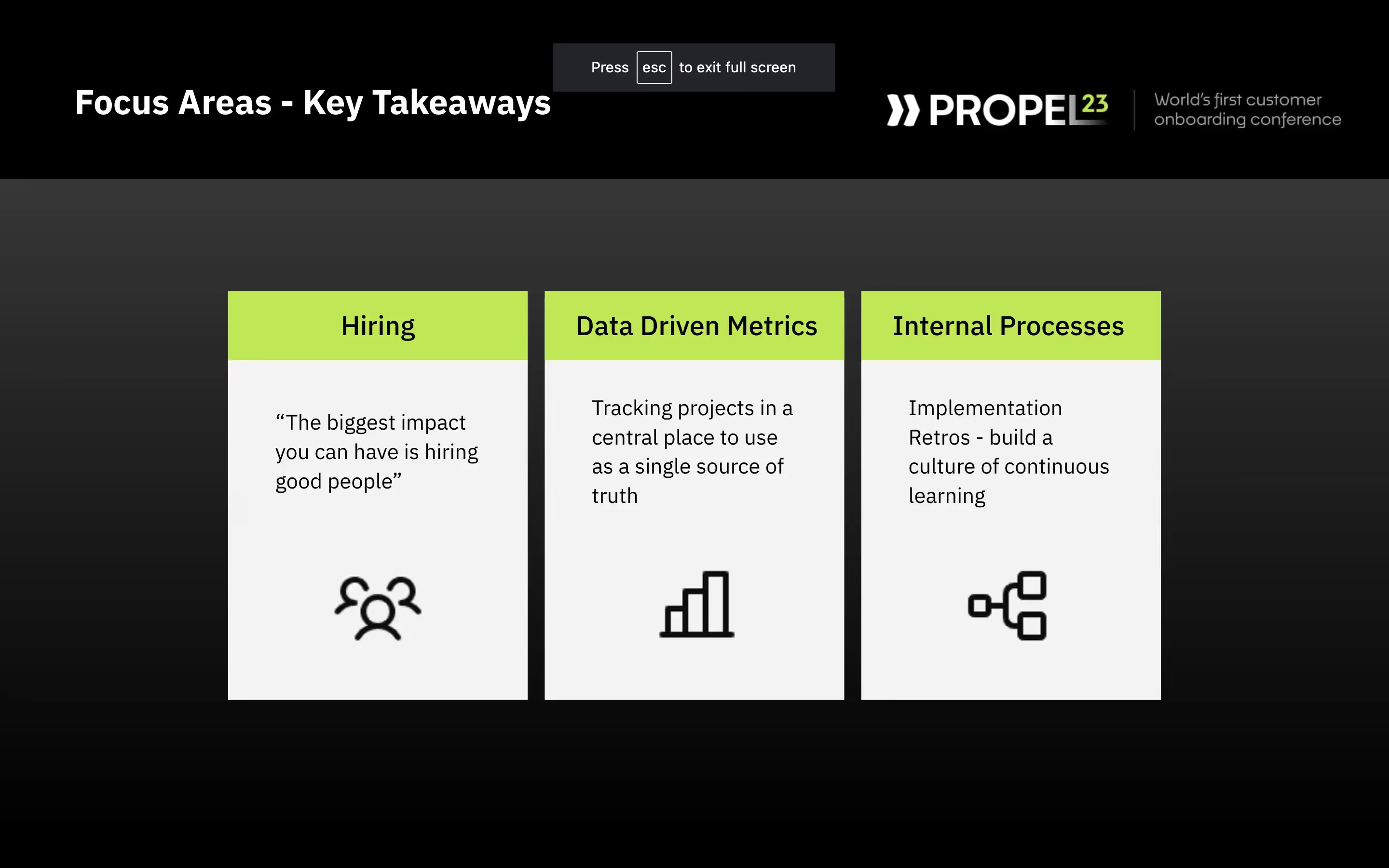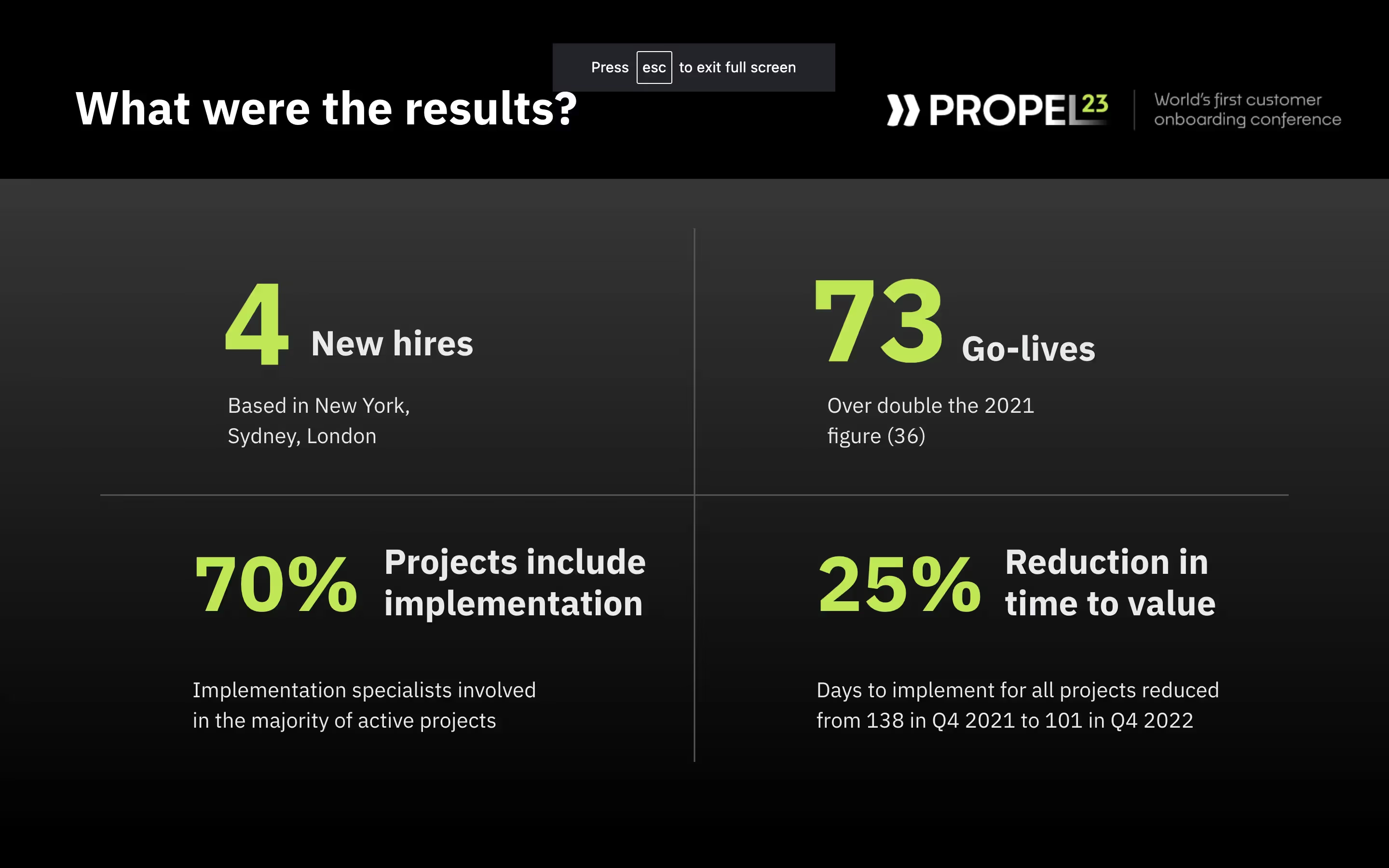More resources:
- Listen to our Propel recordings - The World’s only global conference for customer onboarding
- Look at our Implementation Stories to see the best practices from the most effective implementation teams in the field.
- Discover the compelling conversations taking place in our community through Preflight Conversations.
- Listen to our podcast for all things customer onboarding - The Launch Station
- Explore additional customer onboarding resources from Rocketlane here
At Propel23, Rob Marcall, Implementation Director at Codat, discussed the process of establishing an implementation team from scratch. He highlighted the challenges and emphasized the key areas to focus on to achieve effective results. Rob drew from his experience at Codat and shared the best practices leading to exponential growth.
In this session, Rob spoke about:
- The three main focus areas for building an implementation team
- Codat’s experience with using data-driven metrics to guide implementation
- The role of formalizing internal processes in overall company growth
- The visible results Codatsaw after successfully building an implementation team
Here are the major takeaways and key points from the session.
Overview of Codat
Founded in 2017 in London, Codat is a trusted universal API provider for small business data. With a client base of 300, including both small fintech providers and large financial institutions, Codat enables the fast-tracking of fintech product development to cater to the needs of small and medium businesses. By offering a single integration, Codat facilitates connection with major accounting, banking, e-commerce, and payment platforms commonly used by SMBs.
Codat’s implementation challenges
Codat’s implementation process had three major problems:-
1. Visibility: In many cases, the team saw a drop in client engagement after the purchase stage, making it difficult for the Codat team to gain visibility into the client’s activities and understand their progress with the product.
2. Ownership: The team faced this challenge in two areas. Externally, as an API-first business, clients needed to take high ownership of development work and implement it correctly.
Internally, the main technical owners of implementation were solution engineers who looked after both pre and post-sales. Besides bandwidth constraints, there was another issue – there wasn’t enough focus on post-sales because the team was incentivized to focus on the pre-sales piece. This was the strategic reason to build a dedicated implementation team headed by Rob.
3. Deprioritization of implementation by the client: Although clients signed up rapidly, there was a high churn risk. There were frequent delays in implementing the product. The complexity of the product was partly to blame for this. New integrations and data types were introduced to address the issue. However, these changes made implementation more challenging. It made more sense to have a dedicated implementation function to address these challenges.
Key areas to focus when building a global implementation team

1. Hiring for the implementation team
Dealing with challenges in hiring
Rob initially aimed to have a complete team within six months, but it took longer than expected. Seeking advice from a mentor who had previously built and implemented implementation teams proved transformative. The mentor emphasized the significance of hiring talented individuals, stating, "The biggest impact you can have is hiring good people." This statement altered Rob's perspective, convincing him that assembling a great team would make a greater impact and thus should be his primary focus.
Rob dedicated approximately 6-8 months to the hiring process. However, it came with its fair share of disappointments. They found that only one out of 40 candidates who received an initial job offer ultimately accepted it. Consequently, they employed various sourcing methods to expand their talent pool, including collaborating with regional recruiters, using LinkedIn, encouraging employee referrals, and relying on dedicated recruitment websites like Otta.
Involving other parts of the business
A key factor that aided the hiring process was engaging various departments within the company – especially during the later hiring stage. Allowing candidates to interact with multiple individuals and address their inquiries effectively showcases the company's culture and bolsters their interest in joining the organization.
Consistency and continued learning
Rob realized the importance of consistency in his approach. He followed the same process right from the start. This included standardizing interviewing tasks like presentations and technical assessments. This practice continued as they interviewed other candidates. This approach proved to be very helpful as it made it easy to compare candidates. It also facilitated the hiring process as they were able to build their initial team quickly within the first six to nine months.
One important lesson Rob learned through this process was the importance of continuous learning. He realized that every interview experience, whether positive or negative, provided an opportunity for growth and learning for the entire hiring team. As a result, he adapted his approach and shared his insights with the talent team, enabling them to adjust their candidate sourcing strategies. The experience of hiring individuals also shaped the desired job roles, as they observed the success of certain individuals within the company.
2. Applying data-driven metrics
A single source of truth
Rob's main focus was creating a dashboard on Salesforce. to track the progress of their current implementation. The goal was to concentrate on the current status of projects, identify any issues or obstacles, and then monitor and resolve these issues.
Once the dashboard was built, Rob could conduct regular meetings with sales and clients, analyze trends and individual cases, and bring in additional resources from their teams to address any concerns. This holistic approach allowed Codat to track projects more effectively and have a single source of truth to make informed decisions.
Data maintenance
Data is only good if it's up to date, and Rob placed great emphasis on educating the team about the importance of building, capturing, and utilizing data. To achieve this, regular reminders were added through Slack and email to encourage the team to update the data every few weeks. It was also important to cultivate a culture of maintaining good Salesforce hygiene and make it an integral part of everyone's daily routine. Rob discovered that by presenting the insights and decisions being made, the team felt more accountable, and this approach also boosted adoption and understanding at the customer end.
For instance, when Codat started to track the level of engagement on the customer side, they could reach out to users to get feedback and work with them. This helped them to plan out team resourcing accordingly as well.
Data utilization
Codat is heavily focused on using data to drive its operations. For implementation, they used Looker to create a dashboard that consolidated multiple information points, such as support tickets, API interactions, product usage, and client settings. This centralized system improved efficiency as they no longer needed to access multiple tools to track a client's progress. Additionally, it enabled an easy way to assess a client's status quickly before weekly calls. As a manager, Rob could easily review his team's portfolio and gain a clear understanding of their progress in just 20 minutes.
Enhancing KPI tracking
Codat leverages data to analyze key performance indicators (KPIs) and track progress when transitioning to objective and key results (OKRs). Initially, they used a standardized target of 90 days for all projects without considering the specific use case. However, they discovered that project timelines varied significantly based on different factors. Consequently, Codat modified the metrics to focus on more complex projects requiring longer durations while mapping each use case individually. These changes have allowed them to improve their tracking methodology over time.
3. Formalizing internal processes
Documentation
Previously, there was no documentation of common client lifecycle processes, including the critical pre- and post-sales handover. This was because implementation was not the top priority for those handling implementation. Therefore, it was necessary to develop, refine, and document processes with the solutions team and include documentation for non-standard processes, such as working with resellers instead of direct clients or handling project delays.
Internal education
Using Confluence, Codat built an implementation-specific knowledge base for internal knowledge sharing. This proved useful for educating new team members and the entire company. One notable example is the creation of a standardized methodology for marketing content that showcases the implementation service and Codat's customer-centric approach. In addition, they developed and shared RACI diagrams to ensure internal stakeholders were clear on their roles and responsibilities. The centralized platform also facilitated asynchronous collaboration for Codat's geographically remote team, enabling them to share regional insights, collaborate as a team, and communicate with the wider business.
Implementation retro process
The purpose of the implementation retro process was to document project feedback within the confluence after every project. The implementation specialist or the account manager would prepare a report on the project's progress. These reports would then identify common trends and provide actionable feedback to the wider business. This process helps Codat foster a culture of continuous learning by ensuring specific actions are taken.
Implementation as a premium service
In their first year, they made multiple changes to their commercial pricing model, which posed some challenges. Eventually, they decided to offer implementation as a premium service. This means that customers would pay upfront for different platform levels, with the idea that the more they pay, the more benefits and features they receive. This includes increased touch points, interactions, and access to various tools for seamless interaction with the platform.
Results

1. Global hires
The team was able to hire from across the world, with new hires based out of New York, Sydney, and London.
2. Increase in go-lives
The number of go-lives doubled from 36 to 73 in a year. This notable increase resulted from the leadership's increased focus on implementation and strategic decision-making.
3. More projects include implementation
Over 70% of Codat’s projects now include Implementation as a significant part of the process. This contrasts with the earlier approach, where the Codat team’s involvement in implementation was almost non-existent.
The Codat team aims to ensure that 100% of their future projects include implementation as a key focus area.
4. Reduction in time to value
The team has observed a 25% decrease in the time it takes to see results, going from 138 days to 101 days. This is a significant impact, especially considering they’ve had a full team for only three months – highlighting the value of investing in implementation.
Codat’s board and management now recognize implementation as an important focus area as the company grows.















